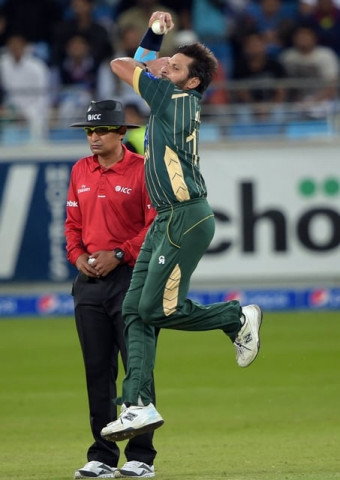Black Caps deny Pakistan yet another trophy amid umpiring howlers
The DRS is not used for T20 Internationals which accentuates the lack of quality in local umpires

Raza turned the game on its head twice with shambolic lbw decisions against Dean Brownlie and Sarfraz Ahmed in the decisive second T20.
Brownlie was given out when the ball was clearly missing the leg-stump and in Pakistan’s reply, Raza dealt a body blow to the hosts by sending back Sarfraz Ahmed — currently the most prolific and in-form player across all formats.
If the decision against Brownlie was bad, the one against Sarfraz was simply horrendous. Raza was also found wanting in the series against Australia, and only the smart use of Decision Review System (DRS) by both teams helped overcome his incompetency.
For some odd reason, the DRS is not used for T20 Internationals, which only accentuates the lack of quality in local umpires.
Another format, another draw
The New Zealand team once again exhibited great resilience to bounce back after a seven-wicket walloping in the first T20.
The UAE tour has followed a similar path for them in two contrasting formats thus far. After a sound beating in the first Test, the Black Caps razed Pakistan to the ground in the final Test and once again roared back in contention to square the T20s.
Bereft of top-performers like Brendon McCullum and Tim Southee, the squad never looked overawed as the players made a quick turnaround within 24 hours of their defeat.
The Shahid Afridi-led Pakistan is banking on a host of young players. The bowlers did a commendable job in both games, but the batting line-up was badly exposed under pressure.
Somehow, Pakistan’s young batsmen seem to take an age to blossom at the highest level. Ahmed Shehzad and Umar Akmal are still to learn the art of closing out a match à la their Indian counterparts, especially Virat Kohli.
Haris Sohail and Saad Nasim have both shown promise but need to be backed up by the selectors for an extended period. Sohail especially played two poor shots, throwing away his wicket needlessly.
Nasim comes across as a calm head and has exceptional fielding skills, but his batting needs to shore up in spite of the early promising.
The lower-order also lacks spine. Afridi has remained a miss-and-hit in 18 years of international cricket, yet his cameo on Friday night once again highlighted his immense value in the instant format.
Anwar Ali and Sohail Tanvir have squandered numerous opportunities of closing out matches in both T20s and ODIs.
Anwar was given a great confidence boost by the team management in Dubai; the right-armer opened the bowling and bowled one good over each in the two matches. But consistency is not his forte for now; if Anwar is harbouring hopes of an extended run at the highest level, he must add a yard of pace or reproduce the booming swing that seems to have been lost at various coaching clinics he has been sent to in recent years.
With two contrasting formats done and dusted, the New Zealand tour now enters the most important phase as the ODI World Cup looms large.
Pakistan have many vacant spots up for grabs for the coveted tournament’s final 15-member squad. The five-match series is likely to be a stern test for the hosts in the wake of their disastrous 3-0 defeat at the hands of Australia in October.
All eyes are set on Younus Khan, Misbahul Haq, Shahid Afridi, Umar Gul and Mohammad Hafeez. The hugely experienced stalwarts have to lead from the front and seal their berths for the World Cup.
We are in for a fascinating fortnight of cricket.
Like Sports on Facebook, follow @ETribuneSports on Twitter to stay informed and join in the conversation.

















COMMENTS
Comments are moderated and generally will be posted if they are on-topic and not abusive.
For more information, please see our Comments FAQ